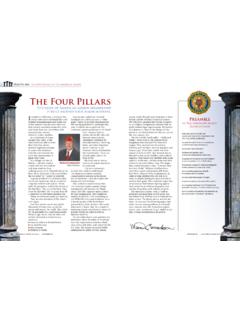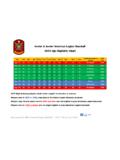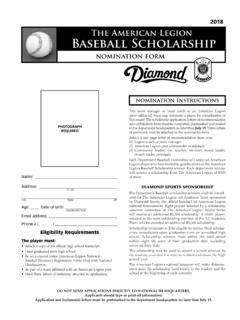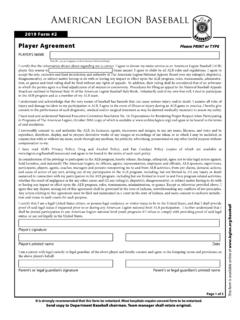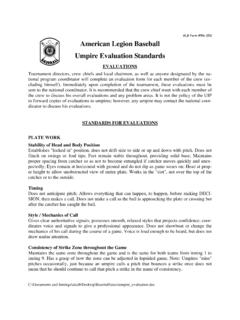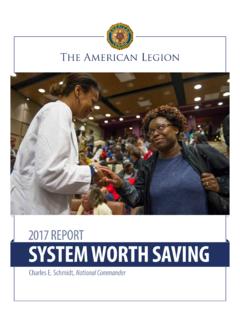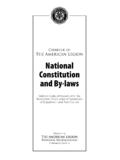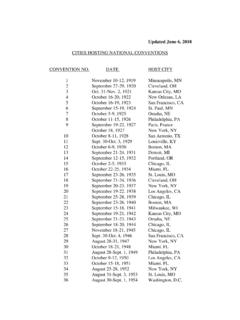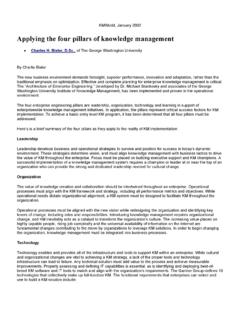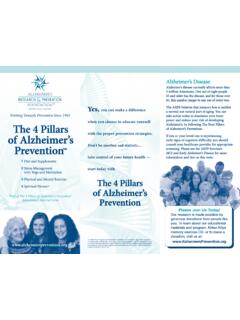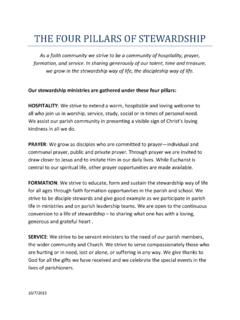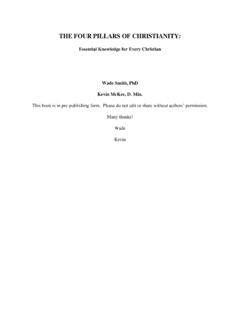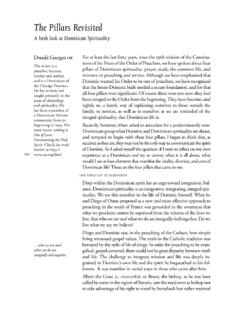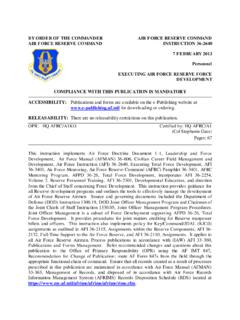Transcription of The Four Pillars of - American Legion
1 OfFour PillarsTheThe American LegionPreambleto The American Legion ConstitutionFOR GOD AND COUNTRY WE ASSOCIATE OURSELVES TOGETHER FOR THE FOLLOWING PURPOSES:To uphold and defend the Constitution of the United States of America To maintain law and orderTo foster and perpetuate a one hundred percent AmericanismTo preserve the memories and incidents of our associations in the Great WarsTo inculcate a sense of individual obligation to the community, state and nationTo combat the autocracy of both the classes and the massesTo make right the master of mightTo promote peace and goodwill on earth To safeguard and transmit to posterity the principles of justice, freedom and democracyTo consecrate and sanctify our comradeship by our devotion to mutual serving: it s who we are In 1919, The American Legion was founded on four Pillars .
2 Veterans Affairs & Reha-bilitation, National Security, Americanism, and Children & Youth. Each of these Pillars encompasses a variety of programs that benefit our nation s veterans, its servicemembers, their families, the youth of America and ordinary citizens. These programs make a differ-ence in hundreds of thousands of lives each organization s positions and programs are guided by resolutions passed by Ameri-can Legion National Convention delegates, and committee and commission members who represent million wartime veterans and their families. These programs, and the men and women who take the time to perform them, are what allow The American Legion to make a difference locally, and on the state and national s who we are and what we join: four PILLARSI.
3 Veterans Affairs & Rehabilitation Access to VA Care Better Funding Formula Support for Veterans with Special Needs Career Opportunities A GI Bill for a New Century Employment and Business Heroes to Hometowns Volunteering Final RespectsII. National Security Strong National Defense Military Quality of Life Homeland Security Foreign Relations Full Accounting of POW/MIAs Operation Comfort WarriorsIII. Americanism Flag Protection Illegal Immigration Voter Registration and Participation Boy Scouts The Pledge of Allegiance Establishment-Clause LawsuitsIV. Children & Youth Child Pornography Catastrophic Illness Intellectual Disabilities Immunization Family Integrity Media Violence Drug Abuse Child Sexual Exploitation 1 Pillar I: Veterans Affairs & RehabilitationSean CrosierFor nearly 90 years, The American Legion has acted as the nation s leading advocate for proper health care, economic opportunity and legal benefits for military veterans.
4 The Legion was instrumental in the creation of the Veterans Administration in 1930 and an ardent supporter of its elevation to cabinet status when it became the Department of Veterans Affairs in 1989. The relationship between VA and The American Legion contin-ues to evolve it has for decades, The American Legion continues to aggressively lobby for adequate funding of VA health care, timely access to facilities, fair rulings on benefit claims and economic opportunities for those who have come home changed by their military experi-ences. A nationwide network of American Legion department service officers works dili-gently to assist veterans as they pursue benefits and care they earned and deserve. At the local, state and national levels, thousands of Legionnaires provide countless hours to help veterans obtain their benefits.
5 The American Legion provides professional representation in claims appeals, discharge disputes and transition assistance from active-duty to civilian status throughout the , as the number of discharged veterans from the global war on terrorism has sur-passed 500,000, the Legion s federally chartered role to support them could not be more profound. The Legion strongly believes that a veteran is a veteran, no matter the war era, nature or location of service. In that light, The American Legion is the only organization that works on behalf of all million veterans and all who will American Legion stands on the front line of change in the pillar of service known as Veterans Affairs & Rehabilitation. It is a complex and vital part of the organization s mission, particularly now, as a new generation of wartime veterans enters the civilian and VA world.
6 Following are Veterans Affairs & Rehabilitation issues of high priority to The American Legion :Access to VA Health CareVA has undergone a well-documented evolution in the past 25 years, dramatically in-creasing quality of care beyond that of the private or public sectors. An equally well-docu-mented problem, however, is access to that high-quality care. Access to VA care continues to be restricted in many ways, including: The adverse effect on veterans as a result of the budget-driven suspension of Prior-ity Group 8 veterans from new enrollment in the VA health-care system, which was in opposition to the Veterans Health Care Eligibility Reform Act of 1996. Construction. Although construction has begun in many areas, more VA facilities await construction in areas where veteran presence has become gradually ubiquitous.
7 The A System Worth Saving American Legion Field Service representatives research and conduct site visits of VA medical facilities throughout the nation each year and produce a compre-hensive assessment. The System Worth Saving report provides in-depth analyses of VA health-care performance in all 21 Veterans Integrated Service project, launched in 2002, con -tinues under the guidance of the Legion s System Worth Saving Task Force and the Veterans Affairs & Rehabilitation The four Pillars of The American LegionCapital Asset Realignment for Enhanced Services (CARES) decision of 2004 identi-fied urgent needs across the country for new VA hospitals and clinics in areas of fast veteran population growth. Five years later, VA announced construction of a stand-alone VA medical center in Denver.
8 However, many other remaining construc-tion projects do not have the funding. The average age of VA medical facilities is approximately 49 years. Care for female veterans. The American Legion agrees with recent reports stating that primary-care settings should promote routine care within primary care or be linked with specialized women s clinics to enhance coordination and comprehen-siveness and, thus, reduce fragmentation of care or potential overuse of care across health systems. However, due to fragmentation of care, it is reported that 49 percent of women veterans have been pushed back to seek comprehensive care outside of the VA health-care system. Long waiting times for appointments drive away veterans in overburdened VA mar-kets.
9 Waiting times for VA doctor appointments can take months. At one point in re-cent years, more than 300,000 veterans were waiting 30 days or more for primary-care appointments. The waiting time to see a VA specialist is typically even more frustrat-ing, often taking months. Failure to adjudicate VA benefits claims and appeals in a timely manner denies ac-cess to veterans in need. VA s backlog of approximately 400,000 undecided disability claims, along with thousands of disputed decisions that have not been reconciled, denies care by delaying it. Adequate staffing. VA health-care facilities must be adequately staffed with health-care providers who receive competitive compensation. In too many markets across the country, doctor, nurse and technician shortages lead VA to seek more expensive and less efficient services from outside providers.
10 Inadequate staffing prevents VA from keeping timely appointment schedules and drives veteran patients away in many markets. Limited access. Restricted access unnecessarily sends veterans to private contractors for health care formerly available to them in VA facilities. Particularly for long-term care and mental-health services, VA increasingly relies on outside contractors who do not understand the unique needs of veterans consistently suffering from such condi-tions as combat-related post-traumatic stress disorder, traumatic brain injury, Agent Orange exposure and other service-connected problems. Rural health care. Veterans in rural areas often are denied access by the sheer dis-tance between their homes and the VA medical centers equipped to serve them.
